Recent Mold Remediation Posts
Mold in HVAC Ducts: Causes and Expert Solutions for Prevention
11/13/2024 (Permalink)
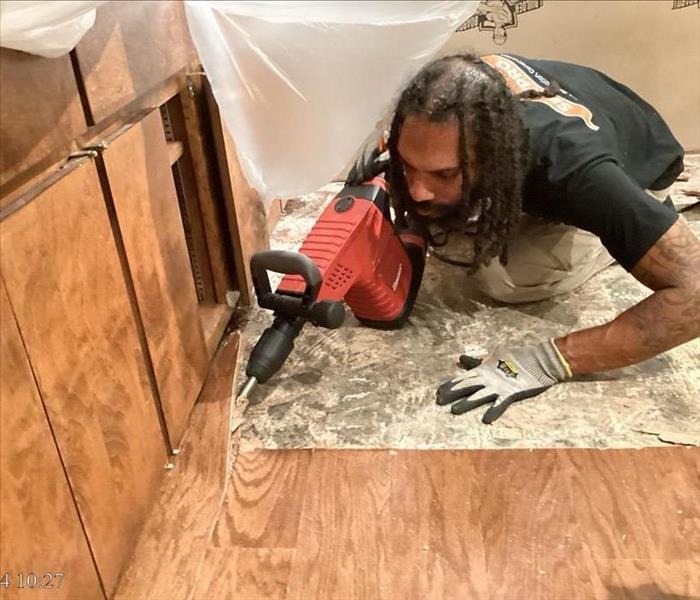 In this blog, we’ll explore the main causes of mold in HVAC ducts and provide expert solutions to keep your system mold-free.
In this blog, we’ll explore the main causes of mold in HVAC ducts and provide expert solutions to keep your system mold-free.
Mold growth in HVAC ducts is a common but serious issue that can significantly impact your home's comfort and safety in Chester County, PA. If left unaddressed, mold in your ducts can reduce the efficiency of your HVAC system and require costly repairs. At SERVPRO®, we understand how crucial it is to tackle mold problems early and effectively. In this blog, we’ll explore the main causes of mold in HVAC ducts and provide expert solutions to keep your system mold-free.
What Causes Mold in HVAC Ducts?
Mold thrives in environments where moisture and organic material are present. Unfortunately, HVAC systems create the perfect conditions for mold growth, particularly when they aren’t properly maintained. Here are the primary causes of mold in HVAC ducts:
1. Excess Moisture
Moisture is the leading cause of mold in HVAC ducts. When your system cools the air, condensation naturally forms on the coils. If there’s excessive humidity in your home or poor ventilation, this moisture may not dry properly, creating a breeding ground for mold. In fact, mold requires only 48 hours of moisture exposure to begin growing.
2. Leaky Ducts
Leaks in your HVAC ductwork can introduce moisture and dirt, both of which contribute to mold growth. Leaks allow humid air from outside or unconditioned spaces like attics and basements to enter the system, which can lead to condensation buildup.
3. Clogged or Dirty Air Filters
Air filters play an important role in keeping contaminants out of your HVAC system. When they become clogged with dust and debris, airflow is restricted, leading to potential moisture buildup inside the ducts. Dirty filters can also allow mold spores to enter the system and circulate through your home.
4. Poor System Maintenance
Routine maintenance is essential for keeping your HVAC system in good condition. Neglecting regular cleaning, inspection, and service can result in dirty coils, leaky ducts, and other issues that promote mold growth.
How to Prevent Mold in HVAC Ducts
The good news is that preventing mold in your HVAC ducts is possible with proactive measures. Below are the expert-recommended steps to prevent mold growth in your system:
1. Regular HVAC Maintenance
Schedule regular inspections and cleanings of your HVAC system. A well-maintained system is less likely to develop moisture issues that lead to mold. Be sure to have the coils, drip pans, and ducts professionally cleaned to remove dirt and moisture.
2. Install a Dehumidifier
In areas with high humidity, installing a whole-home dehumidifier can reduce excess moisture in the air and prevent condensation buildup within your HVAC system. This step is especially important if you live in a humid climate.
3. Seal and Insulate Ducts
Ensuring your ductwork is properly sealed and insulated can prevent leaks and minimize moisture from entering the system. If you suspect any leaks, have them professionally sealed to avoid condensation and mold growth.
4. Replace Air Filters Regularly
Make sure to replace your air filters every 1 to 3 months, depending on the type of filter and your household needs. This prevents mold spores from entering the system and keeps airflow unrestricted.
5. Use UV Lamps
Installing UV lamps inside your HVAC system can help kill mold spores and bacteria before they spread. These lamps are especially effective when placed near the evaporator coil, where moisture tends to accumulate.
Professional Mold Remediation for HVAC Systems
If mold has already developed in your HVAC ducts, it’s essential to call in professionals for remediation. At SERVPRO, we use advanced techniques and equipment to remove mold and prevent future growth. This includes cleaning the affected ducts, applying mold inhibitors, and identifying the source of moisture to ensure it doesn’t return.
Why Mold in HVAC Ducts Should Be Addressed Quickly
Mold in HVAC ducts can impact the efficiency of your heating and cooling system. According to a report by the Environmental Protection Agency (EPA), dirty HVAC systems can reduce efficiency by up to 25 percent due to increased airflow resistance and reduced heat exchange efficiency. By addressing mold issues early, you can prevent costly energy bills and the need for extensive repairs.
At SERVPRO, we are dedicated to providing expert mold remediation services for homeowners. If you suspect mold in your HVAC ducts, don't wait. Contact us today for professional inspection and remediation services to ensure your system is running at peak performance and free from mold.
Recognizing the Telltale Signs of Mold in Your Home
8/7/2024 (Permalink)
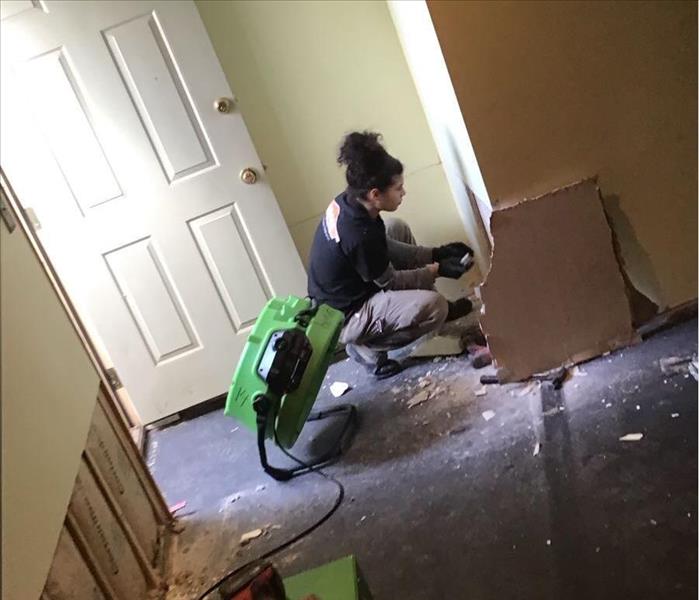 Trust the Pro's with mold remediation! Here are some key indicators that you may have a mold issue in your home:
Trust the Pro's with mold remediation! Here are some key indicators that you may have a mold issue in your home:
As homeowners, we strive to maintain a good environment for ourselves and our loved ones. However, there are certain issues that can arise unnoticed, potentially compromising the integrity of our homes and our personal belongings. One such issue is mold.
Mold is a type of fungus that thrives in damp and humid environments, making our homes susceptible to its growth, especially in areas like bathrooms, kitchens, basements, and attics. While mold can sometimes be visible, it often lurks in hidden corners, making it essential to be aware of the signs that indicate its presence. Here are some key indicators that you may have a mold issue in your home:
- Visible Mold Growth: The most obvious sign of a mold problem is the presence of visible mold growth. Mold can appear in various colors, including black, green, or white, and may resemble spots, patches, or clusters. Pay close attention to areas such as walls, ceilings, floors, and around windows and doors.
- Musty Odor: Mold emits a distinct musty odor that is often described as earthy or stale. If you notice a lingering smell that you can't seem to get rid of, it could be a sign of hidden mold growth behind walls, under flooring, or in other concealed spaces.
- Water Damage: Any past or present water damage in your home, such as leaks, flooding, or water stains, can create the perfect conditions for mold growth. Even if the water damage has been addressed, moisture may still linger in affected areas, providing an ideal environment for mold spores to thrive.
- Allergic Reactions: Mold can trigger allergic reactions in some individuals, causing symptoms such as sneezing, coughing, itchy eyes, and respiratory issues. If you or your family members experience these symptoms indoors but not outdoors, it could indicate the presence of mold.
- Peeling or Discoloration: Peeling paint, wallpaper, or drywall, as well as discoloration or warping of surfaces, can be indicative of moisture problems and potential mold growth underneath. Inspect these areas carefully, especially if they are located in damp or poorly ventilated spaces.
- Humidity Issues: High humidity levels in your home can create an environment conducive to mold growth. Invest in a hygrometer to monitor indoor humidity levels and take steps to keep them within the recommended range (ideally between 30-50%).
If you suspect that you have a mold problem in your home, it's crucial to address it promptly to prevent further damage. While some mold issues can be resolved through DIY methods, it is best to leave jobs like these to the professionals ar SERVPRO, where we have years of experience in mold remediation services.
At SERVPRO, we specialize in mold remediation and restoration, utilizing advanced techniques and equipment to effectively eliminate mold and restore your home to its preloss condition. Our certified technicians are trained to handle mold safely and efficiently, providing you with peace of mind and a healthier living environment.
Don't let mold take control of your home. If you notice any of the signs mentioned above or have concerns about mold growth, contact SERVPRO for a thorough inspection and customized solution tailored to your needs. Your home deserves to be a safe haven for you and your family.
Unveiling the Mold Remediation Process: A Comprehensive Guide
6/19/2024 (Permalink)
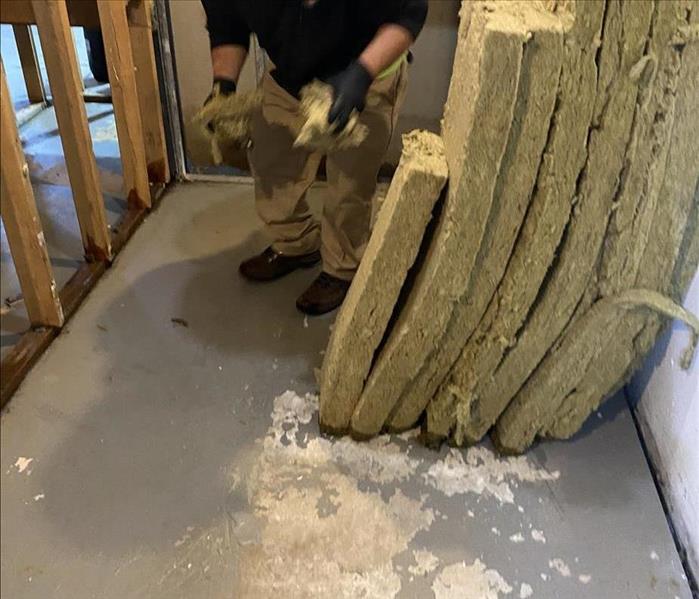 At SERVPRO, we understand the urgency and importance of mold remediation, which is why we're here to shed light on the process of tackling this issue.
At SERVPRO, we understand the urgency and importance of mold remediation, which is why we're here to shed light on the process of tackling this issue.
Mold is a silent intruder that can wreak havoc on your property, causing damage to both your home and belongings if left unchecked. At SERVPRO®, we understand the urgency and importance of mold remediation, which is why we're here to shed light on the intricate process of tackling this pervasive issue.
Understanding the Nature of Mold
Before delving into the remediation process, it's crucial to comprehend the nature of mold. Mold spores are omnipresent, lurking in the air both indoors and outdoors. However, when they find moisture and a suitable environment, they proliferate, forming colonies that can rapidly spread throughout your home.
Assessment and Inspection
The first step in mold remediation is a comprehensive assessment and inspection by our experienced technicians. Using state-of-the-art equipment, we identify the extent of the mold infestation, pinpointing affected areas and determining the underlying cause of moisture.
Containment
To prevent the spread of mold spores to unaffected areas, containment is imperative. Our team utilizes advanced techniques such as negative air pressure chambers and physical barriers to isolate the contaminated zones, minimizing the risk of cross-contamination.
Moisture Elimination
Addressing the source of moisture is paramount in halting mold growth. Whether it's a leaky pipe, roof damage, or poor ventilation, we employ specialized equipment to eliminate excess moisture, restoring the optimal humidity levels in your home.
Removal of Mold-infested Materials
Once containment measures are in place and moisture levels are controlled, our technicians proceed with the safe removal of mold-infested materials. From drywall and carpeting to insulation and furniture, we meticulously remove and dispose of affected items in accordance with industry standards.
Cleaning and Disinfection
After the removal of mold-infested materials, thorough cleaning and disinfection are essential to eradicate any remaining mold spores. Our team utilizes powerful antimicrobial agents and cleaning solutions to sanitize surfaces, ensuring a mold-free environment.
Drying and Dehumidification
To prevent mold recurrence, thorough drying and dehumidification of the affected area are paramount. We deploy industrial-grade air movers and dehumidifiers to expedite the drying process, restoring your property to its preloss condition.
Post-Remediation Verification
Once the remediation process is complete, we conduct a final inspection to ensure that mold growth has been effectively eradicated. Our goal is not just to remove visible mold but to address the root cause and provide long-lasting solutions for a mold neutral indoor environment.
At SERVPRO, we prioritize professionalism, efficiency, and customer satisfaction in every mold remediation project. With our expertise and cutting-edge techniques, you can trust us to restore your home to a safe and mold-free condition. Don't let mold take control of your property – contact us today for comprehensive mold remediation services!
Mastering Mold Testing: Timing and Techniques for Effective Assessment
5/25/2024 (Permalink)
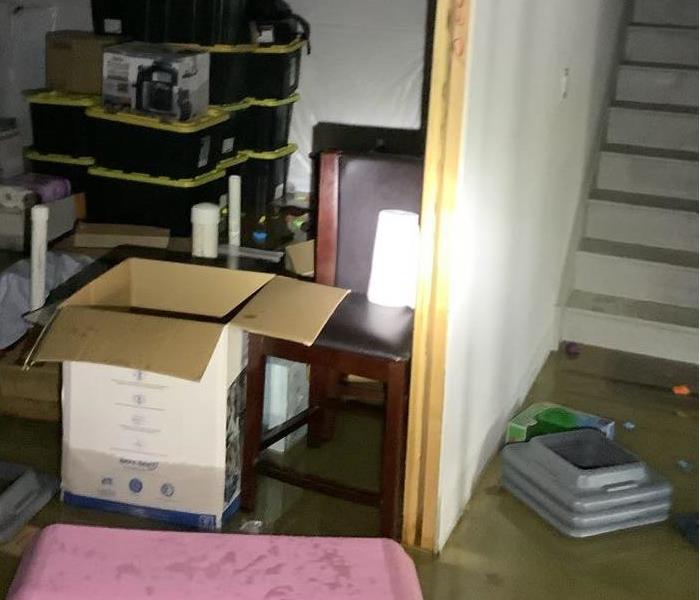 We delve into the timing and techniques for effective mold testing to ensure accurate results and a healthy indoor environment.
We delve into the timing and techniques for effective mold testing to ensure accurate results and a healthy indoor environment.
Mold testing is a crucial step in identifying and addressing mold issues within homes and businesses. Knowing when and how to conduct mold testing properly can help homeowners and property managers make informed decisions about remediation and prevention. In this blog post, we'll delve into the timing and techniques for effective mold testing to ensure accurate results and a healthy indoor environment.
When to Consider Mold Testing
Suspected Mold Growth
If you suspect mold growth in your home or business, it may be necessary to conduct mold testing to confirm the presence of mold and determine the extent of the contamination. Signs of mold growth include visible mold growth, musty odors, and water damage.
Pre-Purchase or Pre-Rental Inspections
Before purchasing or renting a property, it's advisable to conduct mold testing as part of a comprehensive inspection process. This can help identify any existing mold issues that may need to be addressed before moving forward with the transaction.
Post-Remediation Verification
After mold remediation efforts have been completed, mold testing can be conducted to ensure that the remediation is successful and that the indoor environment is free of mold contamination.
How to Conduct Mold Testing
Visual Inspection
Begin by conducting a visual inspection of the property to identify areas of concern and potential sources of mold growth. Look for signs of water damage, moisture intrusion, and visible mold growth on surfaces.
Air Sampling
Air sampling is one of the most common methods used for mold testing. This involves collecting air samples from various areas of the property using specialized equipment. The samples are then analyzed in a laboratory to detect the presence of mold spores and assess indoor air quality.
Surface Sampling
Surface sampling involves collecting samples from suspected mold growth areas using swabs, tape lifts, or bulk sampling methods. These samples are then analyzed in a laboratory to identify the types of mold present and assess the severity of the contamination.
Moisture Testing
In addition to mold testing, it's essential to conduct moisture testing to identify areas of high humidity or moisture intrusion that may be contributing to mold growth. Moisture meters and infrared cameras can help detect hidden moisture within building materials.
Interpretation by Professionals
Mold testing results should be interpreted by qualified professionals who have expertise in mold assessment and remediation. They can provide insights into the severity of the mold problem and recommend appropriate remediation measures based on the findings.
Comparison with Baseline Samples
When conducting post-remediation verification testing, it's essential to compare the results with baseline samples taken before remediation. This allows for an accurate assessment of the effectiveness of the remediation efforts.
Mold testing is an essential tool for identifying and addressing mold issues within homes and businesses. By knowing when and how to conduct mold testing properly, property owners can ensure accurate results and take proactive measures to maintain a healthy indoor environment. If you're considering mold testing for your property, don't hesitate to contact a professional restoration company like SERVPRO® for expert assistance.
Unveiling the Symbiotic Relationship: Mold and Water Damage
3/7/2024 (Permalink)
Water damage and mold often engage in a symbiotic dance, creating a challenging situation for homeowners and businesses. In this blog, we'll explore the intricate relationship between mold and water damage, shedding light on their connection and the crucial role of SERVPRO® in managing these intertwined challenges.
Understanding the Link: Mold and Water Damage
Water damage provides the ideal breeding ground for mold. Whether it's from a burst pipe, a leaky roof, or flooding, excess moisture creates the perfect conditions for mold spores to thrive.
Mold spores are omnipresent, lying dormant until they encounter moisture. When water damage occurs, it serves as the catalyst, activating these spores and initiating the growth of mold colonies.
Hidden Havens in Water-Damaged Spaces
Water-damaged areas, especially those not immediately visible, become hidden havens for mold growth. Behind walls, under flooring, or in damp basements, mold finds refuge in the aftermath of water-related incidents. The longer water damage goes unaddressed, the more time mold has to establish itself. Swift action is crucial to mitigate water damage and prevent the onset of mold infestations.
The Solution: A Vital Intervention
SERVPRO of North East Chester County’s 24/7 restoration response is a critical element in breaking the mold-water damage cycle. Swift action in addressing water damage helps minimize the potential for mold growth. Our expert teams employ advanced techniques for water extraction. By removing excess moisture promptly, they disrupt the conditions that mold spores require to proliferate.
Precision Drying Techniques
We utilize precision drying techniques to ensure that affected areas are thoroughly dried. By eliminating lingering moisture, they create an inhospitable environment for mold.
Our approach includes meticulous cleaning and sanitization of water-damaged spaces. This not only restores the area but also eradicates any mold spores that may have initiated growth.
Preventing Future Mold Incidents
Our expertise extends beyond water damage restoration; they also focus on preventative measures. By addressing the root causes of water damage, they help homeowners minimize the risk of recurrent mold issues. SERVPRO employs state-of-the-art technology to detect hidden water damage and assess the potential for mold growth. This enables targeted interventions to mitigate both water damage and mold infestations.
Water damage and mold share a symbiotic relationship that can pose significant challenges for business owners. However, with SERVPRO's expertise, this cycle can be broken. Through rapid response, thorough restoration, and preventative measures, SERVPRO plays a vital role in disrupting the connection between water damage and mold, restoring homes and businesses to their pre-damage condition, and ensuring a mold-resistant future.
Top 7 Things You Should Know About Mold in Commercial Buildings
10/29/2023 (Permalink)
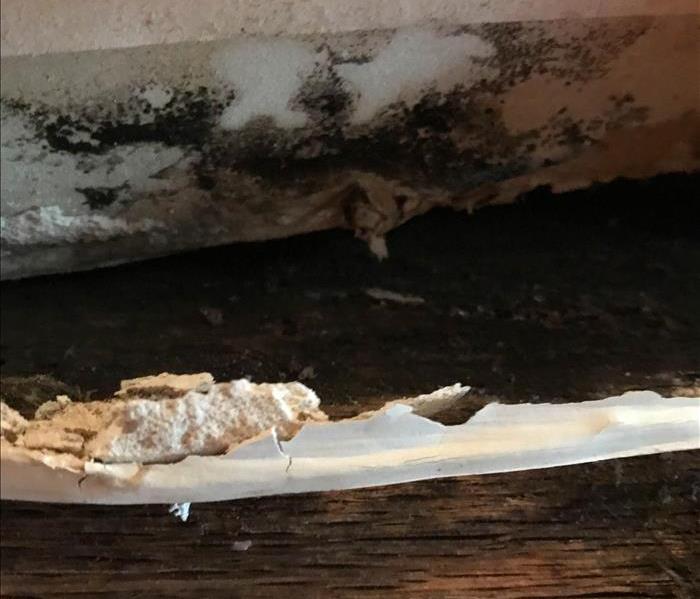 Mold in your commercial building can cause serious damage to you or your employees. Give SERVPRO® a call for your mold remediation needs.
Mold in your commercial building can cause serious damage to you or your employees. Give SERVPRO® a call for your mold remediation needs.
Mold can be a persistent and troublesome issue in commercial buildings, causing not only structural damage but also potential harm to occupants and employees. If you're a business owner or property manager in Chester County, PA, it's crucial to understand the ins and outs of mold in commercial spaces to maintain a safe and healthy environment. In this blog, we'll explore the top things you should know about mold in commercial buildings and how SERVPRO® can assist you in addressing this issue effectively.
Mold Thrives in Humid Environments
Chester County's climate can be quite humid, especially during the warmer months. Mold loves moisture and humidity, making commercial buildings susceptible to infestations. To prevent mold growth, it's essential to maintain proper ventilation, monitor humidity levels, and address any water leaks promptly.
Common Causes of Mold
Mold can develop due to various factors, including water leaks, inadequate ventilation, and poor insulation. Roof leaks, plumbing issues, and condensation are some common culprits. Regular inspections and maintenance can help identify potential problem areas before they escalate.
Signs of Mold Infestation
Recognizing the signs of mold is vital to addressing the issue promptly. Keep an eye out for musty odors, visible mold growth on walls or ceilings, and allergic reactions among occupants. Early detection can prevent mold from spreading and causing extensive damage.
Mold Can Affect Indoor Air Quality
Poor indoor air quality can have a negative impact on the health and productivity of your employees or tenants. Mold spores can become airborne and lead to respiratory issues, allergies, and other health problems. Ensuring good ventilation and air quality is essential for a safe and comfortable workplace.
Mold Remediation Requires Professional Expertise
When mold infestation is confirmed, it's crucial to enlist the help of professionals like SERVPRO® of North East Chester County. Our certified experts have the necessary knowledge, experience, and equipment to safely remove mold and prevent its return. Attempting DIY mold removal can often worsen the situation and pose serious risks.
Prevention Is Key
Preventing mold is more cost-effective and less disruptive than dealing with an infestation. Regular maintenance, prompt repair of water leaks, and implementing moisture control measures can significantly reduce the risk of mold growth in your commercial building.
SERVPRO Can Help
As a trusted restoration and cleaning company in Chester County, SERVPRO offers comprehensive mold remediation services. We employ advanced techniques and equipment to detect, remove, and prevent mold infestations. Our experts can also assist in restoring affected areas, ensuring your commercial space is safe and free from mold-related issues.
Mold in commercial buildings is a serious concern that should not be underestimated. Understanding the causes, signs, and prevention measures is essential for maintaining a healthy and safe workplace in Chester County, PA. If you suspect or detect mold in your commercial property, don't hesitate to contact SERVPRO of North East Chester County for professional mold remediation services. Our team is here to help you address the issue swiftly and effectively, ensuring the well-being of your employees and the integrity of your building.
Mold Cleaning: Understanding the Standards for Effective Mold Remediation
5/25/2023 (Permalink)
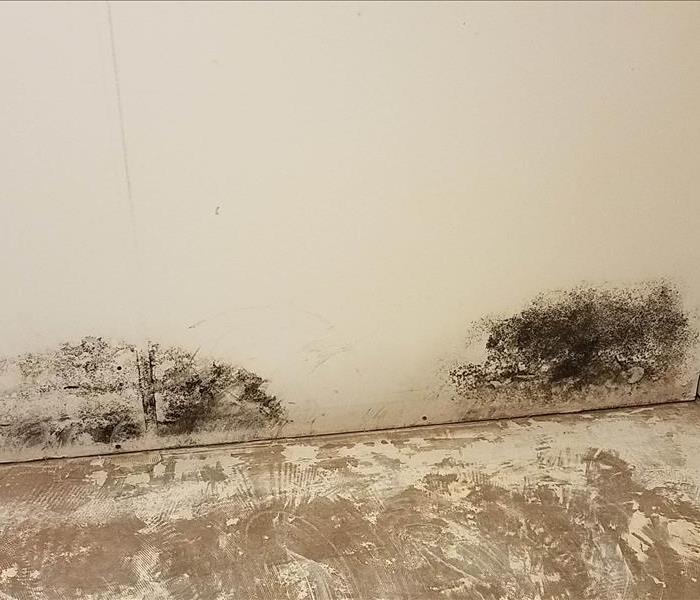 Mold cleanup can be risky, use recommended standard for effective mold remediation.
Mold cleanup can be risky, use recommended standard for effective mold remediation.
Mold growth in homes, offices, and other indoor spaces can pose serious health risks and cause structural damage. Therefore, mold remediation and cleaning are crucial to maintain a healthy indoor environment. But is there a standard for mold cleaning? In this blog, we will explore the concept of mold cleaning standards and their importance in ensuring effective mold remediation.
Standards and Guidelines
Mold cleaning standards are guidelines and protocols that outline the proper methods and procedures for removing mold contamination from indoor environments. These standards are developed and maintained by reputable organizations and agencies, such as the Environmental Protection Agency (EPA), the Occupational Safety and Health Administration (OSHA), the Institute of Inspection, Cleaning, and Restoration Certification (IICRC), and the American National Standards Institute (ANSI). These organizations set the bar for best practices in mold remediation and cleaning, taking into account the latest research, scientific data, and industry expertise.
EPA
One of the most widely recognized and referenced standards for mold cleaning is the EPA's "Mold Remediation in Schools and Commercial Buildings" document, also known as the EPA Mold Remediation Guidelines. This comprehensive guide provides detailed instructions on how to clean up mold contamination in various types of buildings, including schools and commercial properties. It covers topics such as identifying mold, evaluating the extent of mold contamination, protecting workers and occupants during mold cleanup, and proper disposal of moldy materials.
OSHA
OSHA also provides guidelines for mold remediation in the workplace, specifically in construction and general industry settings. These guidelines, outlined in the OSHA Technical Manual, emphasize the importance of assessing and controlling mold exposure to protect workers' health and safety. They cover topics such as respiratory protection, personal protective equipment (PPE), engineering controls, and work practices to prevent the spread of mold during cleanup.
IICRC
The IICRC, a leading organization in the field of inspection, cleaning, and restoration, has also developed the "S520 Standard and Reference Guide for Professional Mold Remediation." This standard provides comprehensive information on mold identification, evaluation, and remediation, as well as guidelines for equipment, containment, and cleaning procedures. The S520 standard is widely used by mold remediation professionals as a reference for best practices.
In addition to these organizations, ANSI has also developed standards related to mold remediation. ANSI/IICRC S500: "Standard and Reference Guide for Professional Water Damage Restoration" includes information on mold remediation as part of the overall water damage restoration process. ANSI/RIA (Restoration Industry Association) 7001: "Standard for Professional Mold Remediation" guides the proper procedures and requirements for mold remediation projects.
It's important to note that mold cleaning standards are not legally binding regulations, but they are widely recognized and followed by industry professionals as the best practices for mold remediation. Adhering to these standards can ensure that mold cleanup is done effectively and safely, protecting the health and well-being of occupants and workers.
In conclusion, while there may not be a single universally recognized standard for mold cleaning, there are widely accepted guidelines and protocols developed by reputable organizations that serve as the industry's best practices. These standards provide valuable guidance on how to effectively and safely remediate mold contamination in indoor environments. If you encounter mold in your home or workplace, it's essential to engage qualified mold remediation professionals who follow these standards to ensure that the mold is properly addressed and removed. DIY mold cleanup is not recommended as it can be risky and may not meet the standards for effective mold remediation.
 In this blog, we’ll explore the main causes of mold in HVAC ducts and provide expert solutions to keep your system mold-free.
In this blog, we’ll explore the main causes of mold in HVAC ducts and provide expert solutions to keep your system mold-free.




 24/7 Emergency Service
24/7 Emergency Service




